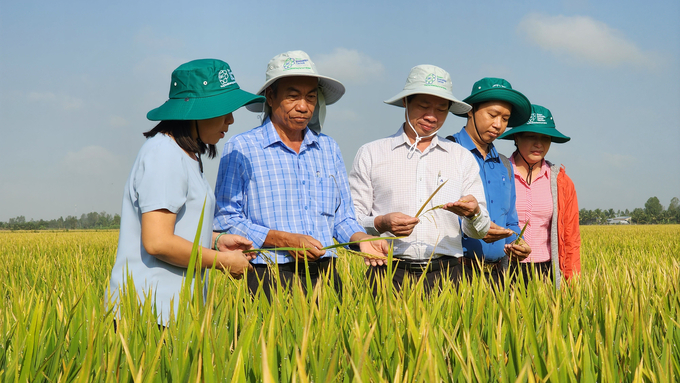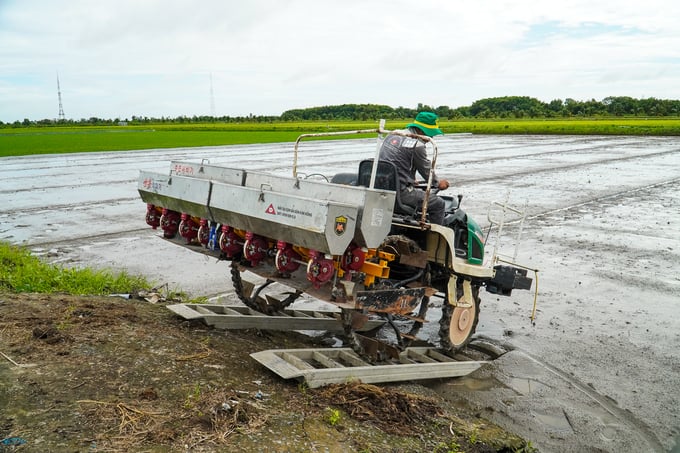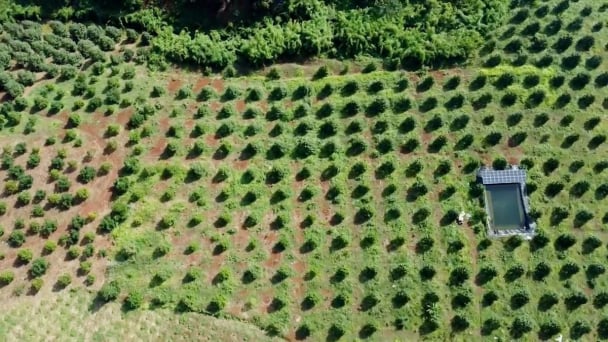June 1, 2025 | 11:59 GMT +7
June 1, 2025 | 11:59 GMT +7
Hotline: 0913.378.918
June 1, 2025 | 11:59 GMT +7
Hotline: 0913.378.918
Agriculture plays an important role in Vietnam's commitment to the United Nations Framework Convention on Climate Change, which aims to cut methane emissions by 30% by 2030, equivalent to approximately 6.8 million tons of CO2e per year and 25.8 million tons of CO2e per year by 2050.
According to the report “Spearheading Vietnam’s Green Agricultural Transformation” conducted by the World Bank (WB), the application of “1 must 5 decreases” (1P5G) techniques can help farmers maintain or increase production output and income, and reduce greenhouse gas emissions effectively.

“1 must 5 decreases” techniques can help farmers produce better while reducing greenhouse gas emissions. Photo: Kim Anh.
To give a simple explanation, 1P5G means “must use certified rice varieties” and “decreases in seeds, chemical fertilizers, pesticides, water and post-harvest losses”. This technique was developed by the International Rice Research Institute (IRRI) and was first implemented in Vietnam in 2013 through the Agricultural Competitiveness Project (ACP).
At that time, the ACP was deployed on a scale of 42,000 ha in some localities in the Mekong Delta. Data collected by IRRI from the 2013 summer-autumn crop showed that applying the 1P5G technique helps farmers reduce the amount of seed used by 29-50%, chemical fertilizers 22 - 50%, water 30 - 50%, and pesticides 20 - 33%.
Moving forward to the time Vietnam implemented the project Vietnam - Sustainable Agriculture Transformation (VnSAT), more than 262,000 rice farmers in 8 provinces and cities in the Mekong Delta were supported to apply 1P5G technology. According to statistics from the World Bank, this technique helped farmers reduce the use of inputs by 20 - 30%, increase rice yield by 3 - 4%, increase the selling price by 5 - 10%, and boost average profit by approximately 28%. The VnSAT project has reduced greenhouse gas emissions by nearly 1.5 million tons of CO2e.

Within the framework of the VnSAT project, more than 262,000 rice farmers in 8 provinces and cities in the Mekong Delta were supported to apply the 1P5G technique. Photo: Kim Anh.
During the 2017 autumn-winter rice crop in Can Tho city, the VnSAT project organized many training courses on 1P5G techniques for farmers in Thoi Lai, Co Do and Vinh Thanh districts. Can Tho Department of Agriculture and Rural Development also organized many 1P5G demonstration sites on a scale of 2 - 3 ha.

1P5G becomes one of the advanced farming techniques in the major programs and projects the Ministry of Agriculture and Rural Development and the Mekong Delta localities are aiming for. Photo: Kim Anh.
According to Tran Thai Nghiem, Deputy Director of Can Tho Department of Agriculture and Rural Development, the organizing of demonstration sites is to affirm the superiority of the 1P5G farming procedure, so farmers can boldly apply the techniques to rice production.
Farmer Nguyen Thanh Hong in Thanh Phu commune, Co Do district (Can Tho) cultivates more than 10 cong of rice land (Vietnamese measurement, 1 cong = 1,300 m2). 100% of this area has applied the 1P5G technical procedure since 2015.
Hong said, “If It is traditional rice cultivation, on average I sow 20 - 25 kg of rice seed/cong for each rice crop, and the amount of fertilizer also falls to 60 kg/cong. After participating in many training programs and tutorials on 1P5G techniques, I boldly apply by reducing the current sowing seed to only 13 kg/cong. As for the chemical and organic fertilizers, I divide them at a ratio of 60:40”.
In terms of efficiency, Hong saves 1.2 - 1.5 million VND/ha in each rice crop compared to the previous traditional methods. 1P5G is thus considered a good rice production procedure at present. It is particularly in line with the orientation of transforming towards low-emission, green and sustainable agriculture.

Applying mechanization in rice production helps to reduce input costs, consistent with the 1P5G techniques. Photo: Kim Anh.
According to a preliminary estimate from the Ministry of Agriculture and Rural Development, the “Scheme for sustainable production of 1 million ha of high quality specialized rice in the Mekong Delta” can potentially reduce over 11.5 million tons of CO2e under the VnSAT project while applying the 1P5G farming procedure.
The World Bank's senior agricultural expert, Cao Thang Binh, said that if Mekong Delta farmers well applied the 1P5G technique, greenhouse gas emissions would be significantly reduced. “Lessons from the VnSAT project showed that the application of 1P5G in rice cultivation can help farmers increase productivity by 5% and reduce greenhouse gas emissions by 8 tons of CO2e/ha/year. If replicated throughout the Mekong Delta region, it is equivalent to reducing 10 million tons of CO2e/ha/year. A rather large number, making an important contribution to the sale of carbon credits”.
Translated by Samuel Pham

(VAN) Several scientists and farmers are experimenting with soil treatment in some key durian-growing regions such as Cai Lay (Tien Giang), Dak Song, Gia Nghia, and Dak R’lap (Dak Nong).
/2025/05/25/4127-3-073637_820.jpg)
(VAN) Thanks to the promotion from an FAO-implemented project, vegetable production in greenhouses in Moc Chau has seen strong development, from 1.5 hectares in 2021 to nearly 50 hectares in 2024.

(VAN) FAO has recently supported USD 140,000 to implement the project 'Risk mitigation human-animal interface risks through disease control initiatives in pig farming.'

(VAN) The People's Committee of Tra Vinh province has approved an adjustment to the investment policy for the Green Hydrogen Plant project, increasing its area to approximately 52.76 hectares.
![Reducing emissions from rice fields: [2] Farmers’ commitment to the soil](https://t.ex-cdn.com/nongnghiepmoitruong.vn/608w/files/news/2025/05/05/dsc08881jpg-nongnghiep-140632.jpg)
(VAN) Clean rice cultivation model in Thuong Tan commune, Bac Tan Uyen district, is assisting local residents in achieving sustainable agriculture by substantially reducing costs, increasing productivity, and protecting the environment.

(VAN) At the conference to disseminate Resolution No. 68, AgriS introduced its digital agricultural ecosystem and reaffirmed its commitment to accompanying the Government in promoting private sector development and sustainable agriculture.

(VAN) 'Blue Ocean - Blue Foods' initiative is designed to restore marine ecosystems and establish sustainable livelihoods for local communities by cultivating a minimum of 1,000 hectares of cottonii seaweed in the first three years.